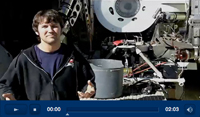
 Today's Weather
Today's Weather
Sunny
Latitude: 30 21' N
Longitude: 89 05' W
Air temperature: 43 F (6.1C)
Barometric pressure: 1026.9
Visibility: unlimited
Seas: Calm
Wind: NNW, 12 mph


Alvin pilot Dave Walter
describes some of the safety features built into Alvin.
Under Way
December 06, 2010 (posted December 7, 2010)
by Ken Kostel
Whenever I find myself growing grim about the mouth; whenever it is a damp, drizzly November in my soul; whenever I find myself involuntarily pausing before coffin warehouses, and bringing up the rear of every funeral I meet; and especially whenever my hypos get such an upper hand of me, that it requires a strong moral principle to prevent me from deliberately stepping into the street, and methodically knocking people's hats off—then, I account it high time to get to sea as soon as I can.
—Moby Dick by Herman Melville
I doubt there was anyone on board who needed to go to sea so badly that he or she felt like knocking someone’s hat off, but there is a noticeable sense of relief that, finally, we are under way.
At 4 p.m. today, with all of the science crew in a mandatory group meeting, Atlantis pulled away from the pier, turned 180 degrees, and aimed south for the Gulf of Mexico. All we felt was a slight rocking when the ship met the first light chop outside the harbor. Meeting adjourned. Almost all of us moved onto the fantail (the rear deck of the ship) or to the rails and catwalks around the ship, which provide wide views of the water. Some watched the land disappear behind us. Some placed last-minute calls before we lost cell phone reception. Some just watched the sun sink in the west.
Eventually, everyone returned to work. There is a lot still to be done, but the fact that we are at sea has made this cruise suddenly feel more real. This is now oceanography. Physical oceanography, biological oceanography, chemical oceanography—it doesn’t matter what kind. To do oceanography you need an ocean, and we are surrounded by it now. The months of planning, the sleepless nights, the endless waiting (even for as short a time as six months) are at an end.
At about 8 a.m. Wednesday, we will arrive at our first location—28°11.86’N, 89°47.85’W—roughly 185 nautical miles south of Gulfport. There we will send an acoustical signal into the water and, we hope, up will bob an orange float a short time later.
Connected to this float will (again, we hope) be an instrument called a sediment trap. This trap consists of a large funnel and a set of collection jars on a rotating stage that gathers material drifting down through the water toward the ocean floor. Every two weeks, a new jar rotates beneath the funnel. With it, scientists can study the type of material settling to the bottom, the rate at which it is settling, and any changes that might occur over time.
This particular instrument was rushed to sea in June as part of a National Science Foundation RAPID cruise (see yesterday’s post). It was meant to supplement another sediment trap that had been placed nearby almost a year earlier. The first was about to make its final sample collection, but because the water above it was occasionally covered by oil from the spill, scientists realized that if another instrument could be deployed quickly, they would get data from before and after the spill and be able to look at how ocean conditions may have changed.
Science is like that sometimes. You take advantage of opportunities to learn something about the world around us. Because that world is constantly changing—sometimes very quickly—you have to be willing to rise to the occasion and respond. That’s not always easy in oceanography. It takes a lot to mobilize a ship and a group of scientists from a wide range of fields in order to get a broad enough view of what’s happening in order to make the effort worthwhile.
On board, we have scientists and students who are interested in everything from how water moves through the ocean to how animals live on the seafloor and how different chemicals can affect those animals, right down to their cells. And right now, all of them are just glad to be at sea.
Read the new interview

Chris German: Chris German, a geologist at Woods Hole Oceanographic Institution, is on a quest for vents, and has become well acquainted with deep-sea technology in the process. Chris is the Chief Scientist for Deep Submergence for the National Deep Submergence Facility, which operates the Alvin submersible, the Jason remotely operated vehicle (ROV), and Sentry. German truly has his finger on the pulse of vent research around the world. Read the interview » [ Previous update ] [ Next update ]
[Back
to top] |



